Frank's travels around Britain 2007.
West Sussex.
 I'm
lying a little, I was around the general Sussex area. Although TV made a right fuss
about the weather, by dodging around and heading south, it was a really nice
trip.
I'm
lying a little, I was around the general Sussex area. Although TV made a right fuss
about the weather, by dodging around and heading south, it was a really nice
trip.
I got an extra day & travelled down in mixed but pleasant weather and was
amazed to learn on the news that the murder of a Hells Angel on the M40 had happened. I must have
passed the spot earlier. The motorway was closed for a couple of days, causing
chaos, that was my first bit of luck. On Monday, the TV programs were predicting
a weather disaster. I remembered the Dorking trip & the prediction that the
world would come to a standstill with snow! OK, they were right about the rain.
It was persistent drizzle during the day (my Mum used to say it was the kind that wet
you through) but the gale winds, floods & the general mayhem just weren't there.
In fact the wind was lovely & warm but nowhere near the gale they predicted. There were people lined up on telly, in the
Tuesday evening, all saying that the entire
summer was a disaster & English weather was worse than Iceland. It just wasn't
true. There were some very pleasant days apart from the
Tuesday. My other trips
this year have been a joy! It was only the trip around Hever that was wet. Seven
breaks & only one that was damp. Some bad weather that was! I realise I'm a
fully paid up member of the Moaning Old Men brigade now, but TV does seem to
thrive on exaggeration and paints a picture with the kneb of it's cap!
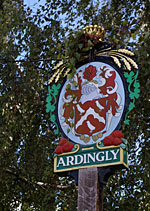 I got a huge surprise on Monday by getting a call to meet my son (down on a
business trip to Brighton) and to get a decent meal bought me in the evening. He
had been caught in the diversions away from the M40 (and his return journey, via
the M25, was
even worse). I
was heading towards Kent when I heard, so I changed direction & wandered around
the Haywards Heath area, covering all the small B roads & looking at the tiny
villages, not too far away from both our lodges. I wanted to find
water, (I like to photograph reflections at the moment, no idea why.) so I found
the Ardingly reservoir on the map. It took ages to follow the signs from the
village. It was then I found out you
couldn't get in the car park, over a huge metal barrier, without a £1 coin. These
things always come up
just when you haven't got the coin & there's no one around who has change
either! No sweat! Nearby there was the Ardingly college big pond (or small lake). A little gem
hidden away from normal view. I bet the fishing was good there too. There were
just moor hens
and fish rising. Hardly a sound of man. Only a tractor a long way off, the wind
rustling & birds
calling in the dense trees.
I got a huge surprise on Monday by getting a call to meet my son (down on a
business trip to Brighton) and to get a decent meal bought me in the evening. He
had been caught in the diversions away from the M40 (and his return journey, via
the M25, was
even worse). I
was heading towards Kent when I heard, so I changed direction & wandered around
the Haywards Heath area, covering all the small B roads & looking at the tiny
villages, not too far away from both our lodges. I wanted to find
water, (I like to photograph reflections at the moment, no idea why.) so I found
the Ardingly reservoir on the map. It took ages to follow the signs from the
village. It was then I found out you
couldn't get in the car park, over a huge metal barrier, without a £1 coin. These
things always come up
just when you haven't got the coin & there's no one around who has change
either! No sweat! Nearby there was the Ardingly college big pond (or small lake). A little gem
hidden away from normal view. I bet the fishing was good there too. There were
just moor hens
and fish rising. Hardly a sound of man. Only a tractor a long way off, the wind
rustling & birds
calling in the dense trees.
There are lovely things to discover on the back roads of England! It is a wise man who said, "You can't possibly get lost, if you don't know where your going"
I saw a pub called the "Smith &
Western" on one road, outside was a display of a tepee, a totem pole & a
small covered wagon. (I guess the
pilgrims travelling out west must have got on with this particular tribe!)
I guess it was a fair enough play on words with the wild west & Smith & Wesson
revolvers! Maybe the owner was like me & had seen too many cowboy films. (Sorry,
Westerns!)
 Further
down was the village of Ditchling, which is on the edge of the South Downs
Way. It looked like, if you could afford to live there, you certainly didn't
want to mix with the grockels that passed through your very pretty & expensive village.
Eric Gill, the sculptor and letter cutter, came to Ditchling in
1907 with his apprentice Joseph Cribb and they were soon followed by other
craftsmen. In 1921 they founded the Guild of St Joseph and St Dominic, a Roman
Catholic community of artists and craftsmen, inspired by ideas of the medieval
guilds and the Arts and Crafts movement. The community had its own workshops and
chapel, and thrived for many years. Its affairs were finally wound up in 1989,
and the workshops demolished. I have noticed that in villages like this place,
there is no one walking, except those who wish to tramp
the South Downs. Residents & visitors seem to pass without talking as they climb in &
out of their expensive cars. You always get the impression that a cheery "Hello"
is a personal affront to their private space. People look irritated by the
narrow streets & busy cross road, in this car filled era. Mind you, they don't
seem mind taking money off the visitors. I guess you shouldn't live in a
beautiful & popular place, if you can't stand tourists! Can it be all that bad? Vera Lynn
once lived here!
Further
down was the village of Ditchling, which is on the edge of the South Downs
Way. It looked like, if you could afford to live there, you certainly didn't
want to mix with the grockels that passed through your very pretty & expensive village.
Eric Gill, the sculptor and letter cutter, came to Ditchling in
1907 with his apprentice Joseph Cribb and they were soon followed by other
craftsmen. In 1921 they founded the Guild of St Joseph and St Dominic, a Roman
Catholic community of artists and craftsmen, inspired by ideas of the medieval
guilds and the Arts and Crafts movement. The community had its own workshops and
chapel, and thrived for many years. Its affairs were finally wound up in 1989,
and the workshops demolished. I have noticed that in villages like this place,
there is no one walking, except those who wish to tramp
the South Downs. Residents & visitors seem to pass without talking as they climb in &
out of their expensive cars. You always get the impression that a cheery "Hello"
is a personal affront to their private space. People look irritated by the
narrow streets & busy cross road, in this car filled era. Mind you, they don't
seem mind taking money off the visitors. I guess you shouldn't live in a
beautiful & popular place, if you can't stand tourists! Can it be all that bad? Vera Lynn
once lived here!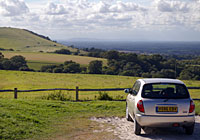
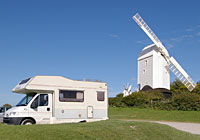 A fabulous discovery was the
two windmills, Jack & Jill, high on the
ridge of the South Downs above Clayton village. They were not marked on my map and they looked beautiful as I meandered
along the road heading towards Hickstead lodge to meet Ian. Jack
is a tower mill or cap mill built in 1866 to replace another post mill, which
dated from 1765. It is unusual that the Jack mill has a male name — almost every other mill
in the country is named after a girl. Jill is a mid-18th Century post mill
(possibly dating from 1821) and was originally located in Brighton, but in 1852
she was dismantled and moved to Clayton, probably by a team of oxen. The working life of the mills ended
in 1906, but Jill has been restored to working order. She produces stone-ground
wholemeal flour on an occasional basis. The vast majority of her flour which is
sold to visitors is ground from organic wheat, grown locally in Sussex. On the
occasions when the wind is blowing and Jill is in operation, a guide is
sometimes available to explain the processes of milling. Jill Windmill is owned
by Mid Sussex District Council, and Jack Windmill is in private ownership.
In April 2007 they
removed two sweeps
for routine inspection, refurbishment and painting. (And I
thought they were called sails!) As it
wasn't a Sunday, I couldn't get in to see the working. Its certainly impressive
place to visit, the views alone are worth it.
A fabulous discovery was the
two windmills, Jack & Jill, high on the
ridge of the South Downs above Clayton village. They were not marked on my map and they looked beautiful as I meandered
along the road heading towards Hickstead lodge to meet Ian. Jack
is a tower mill or cap mill built in 1866 to replace another post mill, which
dated from 1765. It is unusual that the Jack mill has a male name — almost every other mill
in the country is named after a girl. Jill is a mid-18th Century post mill
(possibly dating from 1821) and was originally located in Brighton, but in 1852
she was dismantled and moved to Clayton, probably by a team of oxen. The working life of the mills ended
in 1906, but Jill has been restored to working order. She produces stone-ground
wholemeal flour on an occasional basis. The vast majority of her flour which is
sold to visitors is ground from organic wheat, grown locally in Sussex. On the
occasions when the wind is blowing and Jill is in operation, a guide is
sometimes available to explain the processes of milling. Jill Windmill is owned
by Mid Sussex District Council, and Jack Windmill is in private ownership.
In April 2007 they
removed two sweeps
for routine inspection, refurbishment and painting. (And I
thought they were called sails!) As it
wasn't a Sunday, I couldn't get in to see the working. Its certainly impressive
place to visit, the views alone are worth it.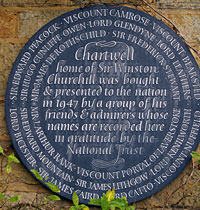
 On
the Tuesday, the
rain made me try to get inside a little. I once tried to get visit Chartwell,
the home of Winston Churchill on another trip but it was closed. This time I was more
successful. Its always annoying to find out you can't take pictures inside
National Trust properties and their like. Plus rain
always puts up my costs if I want to get inside these places too. Chartwell is more like a real home. Obviously only
for the rich & powerful but nevertheless its possible to see that it was
someone's home & not a manifestation of someone wealth & power.
The house has been preserved as it would have looked when Churchill owned it.
(To be correct, it was Sir Winston Leonard Spencer-Churchill & is wife,
Clementine). The rooms are decorated with memorabilia and gifts, the original furniture and
books, as well as honours and medals that Churchill received. It was most
surprising to find out that during the Second World War, the house was mostly
unused. Its relatively exposed position so near to German-occupied France meant
it was potentially vulnerable to a German air strike or commando-style raid. The Churchills instead spent their weekends at Ditchley (further north in
Gloucestershire), until security improvements
were completed at the prime minister's official country residence Chequers.
Chartwell is currently owned by the National Trust. It was bought by a group of
Churchill's very influential & rich friends in 1947, with the Churchills paying
a nominal rent, but was not open to the public until it was presented to the
nation in 1966, the year after Churchill's death. Recorded on a wall were the
names of people who bought Chartwell for Winston. There were only two people
called Mr. on the plaque, James De Rothschild (old moneybags himself) & J. Arthur Rank the film magnet.
(I wonder why old J. Arthur never used his 1st name, Joseph? Was it because his
dad was Joseph & dominated his life?)
I guess that's wealth, power & influence in a nutshell.
On
the Tuesday, the
rain made me try to get inside a little. I once tried to get visit Chartwell,
the home of Winston Churchill on another trip but it was closed. This time I was more
successful. Its always annoying to find out you can't take pictures inside
National Trust properties and their like. Plus rain
always puts up my costs if I want to get inside these places too. Chartwell is more like a real home. Obviously only
for the rich & powerful but nevertheless its possible to see that it was
someone's home & not a manifestation of someone wealth & power.
The house has been preserved as it would have looked when Churchill owned it.
(To be correct, it was Sir Winston Leonard Spencer-Churchill & is wife,
Clementine). The rooms are decorated with memorabilia and gifts, the original furniture and
books, as well as honours and medals that Churchill received. It was most
surprising to find out that during the Second World War, the house was mostly
unused. Its relatively exposed position so near to German-occupied France meant
it was potentially vulnerable to a German air strike or commando-style raid. The Churchills instead spent their weekends at Ditchley (further north in
Gloucestershire), until security improvements
were completed at the prime minister's official country residence Chequers.
Chartwell is currently owned by the National Trust. It was bought by a group of
Churchill's very influential & rich friends in 1947, with the Churchills paying
a nominal rent, but was not open to the public until it was presented to the
nation in 1966, the year after Churchill's death. Recorded on a wall were the
names of people who bought Chartwell for Winston. There were only two people
called Mr. on the plaque, James De Rothschild (old moneybags himself) & J. Arthur Rank the film magnet.
(I wonder why old J. Arthur never used his 1st name, Joseph? Was it because his
dad was Joseph & dominated his life?)
I guess that's wealth, power & influence in a nutshell.
 While
I was there, I
read a leaflet about Sissinghurst castle. It was famous for its gardens & the
owner Vita Sackville-West. It was certainly different! It didn't look like a
castle. It was very long & narrow & had a tower with rooms in it. The traces of
the moat were sparse & the "wonderful gardens" would only be appreciated by a
gardener, not a philistine like me. Sissinghurst's garden was
created in the 1930s by Vita Sackville-West, poet and gardening writer, and her
husband Harold Nicolson, author and diplomat. Sackville-West was a writer on the
fringes of the Bloomsbury group who found her greatest popularity in the weekly
columns she contributed as gardening correspondent of The Observer, which
incidentally—for she never touted it—made her own garden famous. I must say, on
a clear day, I bet the views from the tower were wonderful.
While
I was there, I
read a leaflet about Sissinghurst castle. It was famous for its gardens & the
owner Vita Sackville-West. It was certainly different! It didn't look like a
castle. It was very long & narrow & had a tower with rooms in it. The traces of
the moat were sparse & the "wonderful gardens" would only be appreciated by a
gardener, not a philistine like me. Sissinghurst's garden was
created in the 1930s by Vita Sackville-West, poet and gardening writer, and her
husband Harold Nicolson, author and diplomat. Sackville-West was a writer on the
fringes of the Bloomsbury group who found her greatest popularity in the weekly
columns she contributed as gardening correspondent of The Observer, which
incidentally—for she never touted it—made her own garden famous. I must say, on
a clear day, I bet the views from the tower were wonderful.
 On
the Wednesday, expecting more rain, I headed towards the forecasted better
weather, back south. In contrast to Chartwell, I went to look at Polesden Lacey.
The home of the mega rich with Royal
connections, the legendary enigmatic Edwardian hostess, Mrs
Ronald Greville. Born under shrouded circumstances, Margaret Greville was
reputedly the illegitimate daughter of William McEwan, founder of the famous
Edinburgh brewing empire. A millionaire and philanthropist.
On
the Wednesday, expecting more rain, I headed towards the forecasted better
weather, back south. In contrast to Chartwell, I went to look at Polesden Lacey.
The home of the mega rich with Royal
connections, the legendary enigmatic Edwardian hostess, Mrs
Ronald Greville. Born under shrouded circumstances, Margaret Greville was
reputedly the illegitimate daughter of William McEwan, founder of the famous
Edinburgh brewing empire. A millionaire and philanthropist.
 Backed
by his great wealth and power, she found her way into London society where she
met her husband, Ronald, himself a great friend of Edward VII (who thought her
'gift of hospitality' amounted to 'positive genius'). For several years Mr & Mrs
Greville's life revolved around entertaining the rich and famous, including the
King, at their fashionable London home, but Margaret Greville wanted to outshine
other London hostesses by having a second home in the country. The house was
converted by Mewes and Davis, the architects of the newly built Ritz Hotel.
Backed
by his great wealth and power, she found her way into London society where she
met her husband, Ronald, himself a great friend of Edward VII (who thought her
'gift of hospitality' amounted to 'positive genius'). For several years Mr & Mrs
Greville's life revolved around entertaining the rich and famous, including the
King, at their fashionable London home, but Margaret Greville wanted to outshine
other London hostesses by having a second home in the country. The house was
converted by Mewes and Davis, the architects of the newly built Ritz Hotel.
Mrs
Greville had a lifelong devotion to the House of Windsor. She was especially
fond of Queen Mary (consort of George V) and of Queen Elizabeth the
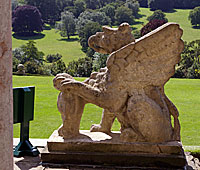 Queen
Mother, part of whose honeymoon was spent at Polesden in 1923, and whom the
childless Mrs Greville loved like a daughter. Mrs Greville was adored by her
friends and feared by her rivals for her indiscreet and acerbic wit. Following
the premature death of her husband in 1908, she divided her time
between travelling abroad during the winter, and holding lavish dinner parties
at both Polesden Lacey and her London home. She became the 'Prima Donna' of
Edwardian society hostesses over the next 30 years, as famous for her exquisite
French cuisine as for her distinguished guests. Photographs recording the
various occasions when royalty, heads of state, politicians and titled
dignitaries were entertained are scattered throughout the house. A sizeable and
diverse art collection provides much fascination at Polesden Lacey, with
everything from Dutch Old Masters (an
inheritance from her father) to oriental porcelain and contemporary jewellery.
Mrs Greville bequeathed Polesden Lacey to the National Trust in 1942 in memory
of her father. It is truly huge, stuffed by wealth & influence with incredible
riches.
Queen
Mother, part of whose honeymoon was spent at Polesden in 1923, and whom the
childless Mrs Greville loved like a daughter. Mrs Greville was adored by her
friends and feared by her rivals for her indiscreet and acerbic wit. Following
the premature death of her husband in 1908, she divided her time
between travelling abroad during the winter, and holding lavish dinner parties
at both Polesden Lacey and her London home. She became the 'Prima Donna' of
Edwardian society hostesses over the next 30 years, as famous for her exquisite
French cuisine as for her distinguished guests. Photographs recording the
various occasions when royalty, heads of state, politicians and titled
dignitaries were entertained are scattered throughout the house. A sizeable and
diverse art collection provides much fascination at Polesden Lacey, with
everything from Dutch Old Masters (an
inheritance from her father) to oriental porcelain and contemporary jewellery.
Mrs Greville bequeathed Polesden Lacey to the National Trust in 1942 in memory
of her father. It is truly huge, stuffed by wealth & influence with incredible
riches.
 I
kept heading south into the sun via Box Hill again. I expected to see a riot of
flowers & butterflies they claim it's famous for but I think, they too, had gone on their holidays. The view
across Dorking wasn't much
improved from the last time I was there.
I
kept heading south into the sun via Box Hill again. I expected to see a riot of
flowers & butterflies they claim it's famous for but I think, they too, had gone on their holidays. The view
across Dorking wasn't much
improved from the last time I was there.
After that I went to Littlehampton to get some fresh seaside air. It was all sunshine, pebbles, flats over looking the sea & your usual seaside fish & chips. I had no idea why I thought Littlehampton would be nicer. I expected the middle class & refinement. Instead I got warm bracing winds & an ozone full seaside! So what do you expect so near Brighton? Maybe I was influenced by Osbert Lancaster's cartoon of Maudie Littlehampton. Osbert sympathetically mocked the British upper classes, personified by his characters William (8th Earl of Littlehampton, formerly Viscount Draynflete) and his wife Maudie. During his Express career he drew some 10,000 cartoons over a period of 40 years. I just may have believed that Littlehampton was upper-class. After all, my Dad read the Express & must have seen it, as it crept inside my brain!
A lady in the guardian was quoted as saying about Littlehampton "They still take ration books in some shops, I swear. If wall-to-wall purveyors of pine furniture and charity shops selling picture books of Sussex circa 1963 is your bag, this is your place. It drove me mad as a teenager, but guess where I moved to when I had kids?" I think that may still stand! In the R.A.F., any Littlehampton's would have been known as "Small Willy" or "Ivor".
Links for information on this page:
